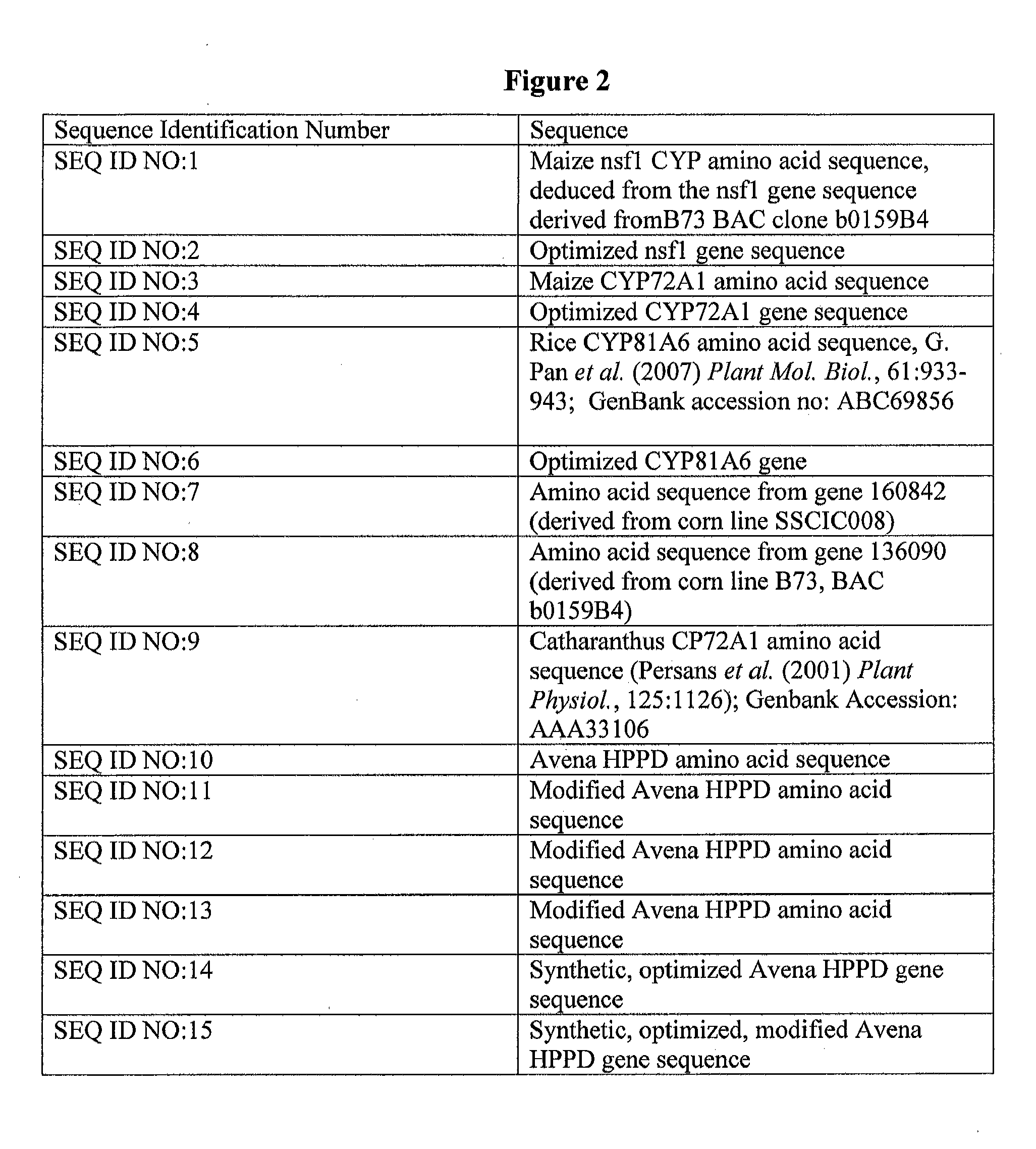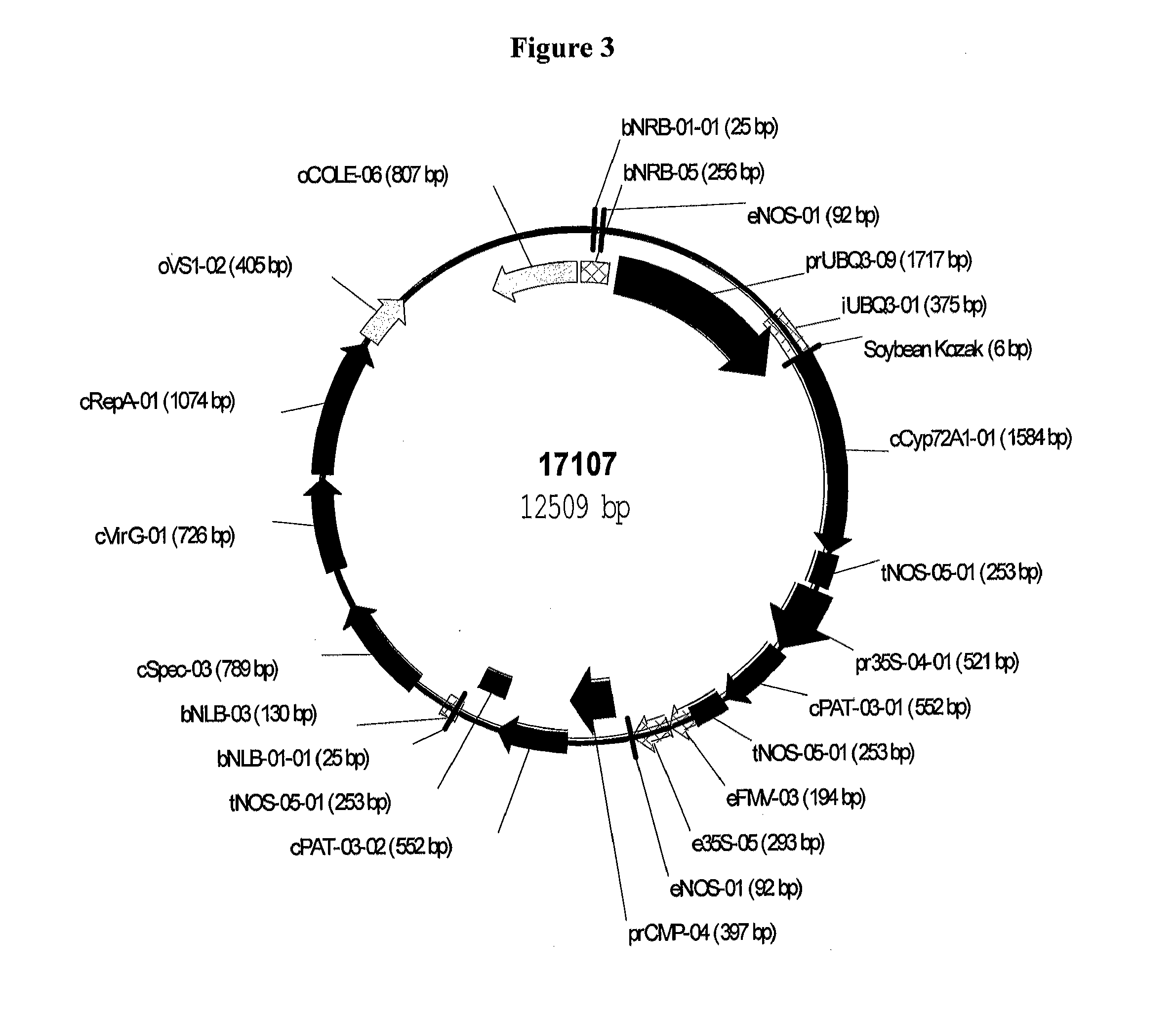Cytochrome p450 genes conferring herbicide resistance
a technology of cytochrome p450 and herbicide resistance, applied in the direction of biocide, plant growth regulator, enzyme, etc., to achieve the effect of conferring resistance or tolerance and reducing hppd herbicide residue levels
- Summary
- Abstract
- Description
- Claims
- Application Information
AI Technical Summary
Benefits of technology
Problems solved by technology
Method used
Image
Examples
example 1
Gene Cassettes Suitable for Engineering Tolerance to HPPD Herbicides and, in Particular Mesotrione, into Crop Plants
[0129]For example a DNA construct is made which has 1) a cassette having an Avena HPPD gene as in SEQ ID NO:14 or SEQ ID NO:15, for example, encoding a protein of or at least 85% similar to SEQ ID NO:10, or a modified Avena HPPD gene (e.g., encoding the amino acid sequence set forth in SEQ ID NO:11, 12, or 13), as described above, under operable expression control of an upstream promoter, such as a tobacco, Arabidopsis or soybean small subunit of Rubisco promoter region including 5′ untranslated leader sequence and a downstream nopaline synthase 3′ terminator sequence adjacent to a second cassette 2) having a DNA sequence encoding the maize nsfl or the rice CYP81A6 protein sequence (SEQ ID NO:1 or SEQ ID NO:5) under operable control of an upstream Arabidopsis or soybean polyubiquitin promoter and 5′ untranslated leader sequence and a downstream 3′ terminator sequence f...
example 2
Transformation of Tobacco with Test CYP Genes and Selection of Herbicide-Resistant Lines
[0131]Candidate full length genes were synthesized, including useful restriction sites, and a translational enhancer sequence 5′ to the start site. These gene cassettes were cloned downstream of the FMV promoter, and these gene cassettes were next cloned into transformation vectors containing either a bar or PPO selectable marker gene cassette.
[0132]Alternatively, candidate full length cyp genes obtained from maize or rice cDNA libraries are edited by PCR to include, for example, 5′ Nco1 and 3′ Kpn1 ends.
[0133]This product is then ligated into pMJB1. pMJB1 is a pUC19 derived plasmid which contains the plant operable double enhanced CaMV35S promoter; a TMV omega enhancer and the NOS transcription terminator. A schematic representation of the resulting plasmid is shown in FIG. 2 of WO 98 / 20144. The expression cassette, comprising the double enhanced 35S promoter, TMV omega leader, 4-HPPD gene and n...
example 3
Transformation of Soybean and Selection of Herbicide-Resistant Plants
[0140]Linear DNA suitable for use in bombardment-based plant transformation is produced by digesting a vector comprising the desired genes (e.g. as in Example 1). This desired fragment is then purified on an agarose gel and isolated using a Biotrap.
[0141]Optionally, the CYP, the HPPD gene or both together can provide the means of selection and identification of transgenic tissue. Optionally the gene for expression of CYP and, for example, Avena sativa HPPD can be present in the polynucleotide alongside other sequences which provide additional means of selection / identification of transformed tissue including, for example, the known genes which provide resistance to kanamycin, hygromycin, phosphinothricin, butafenacil or glyphosate. Alternatively these selectable marker sequences may be present on separate polynucleotides and a process of, for example, co-transformation and co-selection is used. Alternatively, rather...
PUM
 Login to View More
Login to View More Abstract
Description
Claims
Application Information
 Login to View More
Login to View More - R&D
- Intellectual Property
- Life Sciences
- Materials
- Tech Scout
- Unparalleled Data Quality
- Higher Quality Content
- 60% Fewer Hallucinations
Browse by: Latest US Patents, China's latest patents, Technical Efficacy Thesaurus, Application Domain, Technology Topic, Popular Technical Reports.
© 2025 PatSnap. All rights reserved.Legal|Privacy policy|Modern Slavery Act Transparency Statement|Sitemap|About US| Contact US: help@patsnap.com



